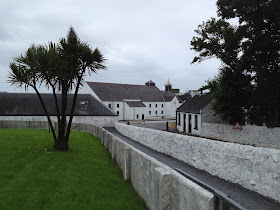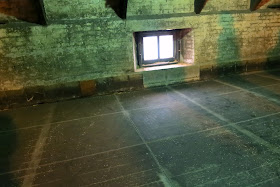This was the point where I truly realized the depth of my mistake in taking the B road two days before. The A road is infinitely more pleasant and easier to ride. While there are hills, they were usually gentle and weren't the interminable slogs that one finds on the east side of Kintyre. Live and learn, I suppose.
It started raining again only a few miles from Kennacraig, which unfortunately meant that I was pretty much soaked by the time I rolled into the ferry terminal. However, that was pretty minor in comparison to the fact that I had managed to ride over 30 miles to reach my destination with time to spare. I rolled my bike onto the ferry, tied it up, and walked upstairs to the observation lounge.
I made one mistake at this point, though it was through ignorance more than anything else. It turns out that passengers aren't allowed on the car deck while the ferry is underway. I was so tired that I hadn't gone back down to grab anything else out of my panniers before we left the dock, so I was stuck in wet clothes with nothing to entertain me but my iPhone (with diminishing battery power) for several hours. While it was far from the end of the world, I was definitely kicking myself.
There wasn't much to look at after we passed out of sight of the Kintyre peninsula. It was still fairly cloudy, so the water and sky formed an almost uniform bubble around the ferry. After something like an hour and a half, we finally sited the Islay coast. It slid by rapidly and I got my one opportunity to see the Kildalton distilleries from the water.
 |
| Ardbeg - the first distillery we passed |
 |
| Lagavulin on the left, Ardbeg on the right - they really are that close to each other |
 |
| Laphroaig on its pretty bay |
 |
| The industrial bulk of the Port Ellen maltings overshadowing the remaining distillery buildings |
While it was still cloudy and rather blustery, the walk was actually rather pleasant. I had to keep an eye out for cars coming down the road as there wasn't much of a shoulder, but once again most of the drivers were polite and gave me plenty of space. The southern end of Islay has an austere beauty, as most of the terrain is rock and grass, with only occasional stands of trees.
The first sight of Laphroaig is actually their warehouses alongside the main road. In some ways they feel very representative of the distillery itself, with a mix of old and new.
The bulk of the distillery is hidden behind a small, neat forest, which opens up to reveal a cluster of whitewashed buildings.
It's hard to avoid the sense that Laphroaig is an industrial site. While the kiln's pagodas provide a quaint touch, the newer buildings are all business.
I had arrived a bit early for my tour, so I wandered around the distillery grounds and peeked into the visitor center.
The small group clustered around as Danielle began our tour. We began with the malt barns, where Laphroaig malts ~20% of the total barley they use, with the balance coming from Port Ellen.
After germinating the barley, it is smoked for 20 hours, consuming 2 tons of peat in the process, to a final phenol content of 40 PPM. The peat needs to be damp, but not wet, to produce smoke instead of fire - peat used for heating tends to be bone dry, so it burns much more cleanly. We learned that peat cut by hand retains more moisture than peat cut mechanically, so Laphroaig sticks to using hand cut peat in their kiln. The remaining hot air used to get the moisture content sufficiently low is cleverly recycled from the waste heat thrown off by the stills. We got to see the inside of their kiln, but they were getting ready to shut down the distillery for a few days, so it wasn't in use.
 |
| Peat, ready to be added to the kiln |
From there we moved to the mash tun and washbacks. This was quite a turn from the very traditional malt floors and kiln - Laphroaig uses all stainless steel for their mash tun and washbacks, which gives the space a very industrial look. It wasn't always this way, but it is the direction that Laphroaig has moved in over time.
 |
| The single enormous mash tun |
 |
| Washbacks with fitted pipes for venting carbon dioxide |
We got to try some of the fresh wash which was, to put it mildly, unpalatable. It's essentially very peaty beer, but unclarified, which means that it is also very, very yeasty. Thankfully they don't stop at that point.
We stepped across the main courtyard into the stillhouse. Laphroaig possesses a motley collection of stills - four spirit stills of varying size and three wash stills. This is because a) the stills were installed at different times as production capacity was expanded and b) the stillhouse is relatively small, which prevented a smaller number of larger stills from being put in.
The wash stills are of fairly standard construction, though smaller (10,500 liters) than any other on the island save those of the tiny Kilchoman distillery. They are charged to 83.5% of capacity, which reduces the copper contact, producing a heavier spirit. At the same time, they are relatively tall for their size and the lyne arms rise slightly, which increases reflux and gives a lighter spirit.
The low wines are then charged into their spirit stills. These are also very, very tiny considering the output of the distillery, with capacities of 4,700 and 9,400 liters. These are also charged near capacity to reduce copper contact. However, the lamp glass shape, with a narrow throat opening into a wider neck along with the slightly rising lyne arms will all increase reflux, giving a lighter spirit. Laphroaig makes its spirit cuts from 72-62.4%, which leaves out most of the lighter vapors while retaining more of the heavier ones (though not as much as, say, Ardbeg). This gives a very smoke-focused spirit, without some of the lighter fruity compounds that end up in the broad foreshots cut.
The new make spirit is then cut down to a standard 63.5% and filled almost exclusively into first-fill bourbon barrels, mostly from Maker's Mark. As Laphroaig is now owned by Fortune Brands, who also own Jim Beam and Maker's Mark, there is always a ready supply of fresh ex-bourbon barrels. That used to be just about it for Laphroaig, though they have now branched out into various cask finishes, such as sherry, quarter casks, and new oak. We got to glance inside one of the low-ceilinged dunnage warehouses, but sadly weren't able to go in.
 |
| What the mold adds to the maturing whisky, nobody knows |
After the tour wrapped up we got to sample a number of different Laphroaig single malts. I particularly enjoyed the 10 Year Cask Strength (though unfortunately it's been rather tricky to find a bottle since returning to the States).
Considering everything I had seen, Laphroaig seems to be an exercise in tension between past and present. Even looking into their own visitor center, one can see some of the ways that the distillery has changed over time. For a good overview, scroll down for the "Laphroaig, Flavour and Accountants" story on Laphroaig Collector.
 |
| The old stillhouse, with worm tub condensers |
 |
| Installing modern condensers |
Another example would be the shift towards NAS single malts. Laphroaig used to have a rather limited portfolio - the standard 10 Year, a 10 Year Cask Strength, 15 Year and occasional special 25 and 30 Year releases. The 15 Year has since been replaced with an 18 Year, while the rest of the range has been supplemented with an increasing number of NAS malts. It began with the Quarter Cask, which begins life in the usual first-fill bourbon casks, but is then transferred to smaller quarter casks for a short period of time. The result is similar to, but not the same as, the 10 Year and prices are generally on par between the two. Since then a number of other expressions have come out, usually first in duty free shops. The Triple Wood is similar to the QC, but adds an additional layer of sherry cask maturation on top. PX Cask and QA Cask (fresh oak casks) have also made appearances. These are all a significant departure from tradition, as Laphroaig maintained a sort of 'no funny business' policy when it came to wood management for many decades. The current direction seems to be acknowledging the fact that the distillery has limited supplies that it is attempting to stretch via various cask finishes, which allow them to release 'mature' whisky in less time. While this is generally the direction that the industry is taking as a whole, it does significantly change the nature of the spirit Laphroaig is bottling now compared to ten or twenty years ago.
With all that said, it's clear that Laphroaig has staked out a solid niche for itself in the whisky world. As others have put it, they're the Marmite of scotch - you either love it or hate it. And those who love it really love it. There really isn't anything else on the market with the same quality of smokiness to it, which is quite intense despite having a lower peating level than Ardbeg (though I'll explain some of why when I talk about touring that distillery). I'll be exploring their malts more in future, to try to get my head around them.
My walk back to Port Ellen from the distillery was, if anything, even more pleasant as I was warmed by the smoky drams I had consumed. It was really nice to be able to move at a slower pace, soaking up the landscape and giving myself time to ruminate about the place I had just visited. The smell of peat fires added to the sense of place as I got closer to town, wreathing the place in a warm and pleasant reek.
I ended up going to an Indian restaurant in Port Ellen for dinner - one of the residual benefits of empire appears to be decent food from the subcontinent just about everywhere in Scotland. After that I popped into the bar next door to the B&B where I was staying. After peeking at their fairly broad selection of single malts, I settled on the most recent Laphroaig Cairdeas release. Even more enjoyable than the whisky was the company - I ran into several couples who I had met over the course of the day, either on the ferry or at the distillery. I even ended up being introduced to another couple from Portland who were also on Islay to see some of the distilleries. All in all, it was a fun evening and a really nice way to end a long day.
It was quite satisfying to crawl into bed, knowing that I had the other two Kildalton distilleries to look forward to the next day.








































